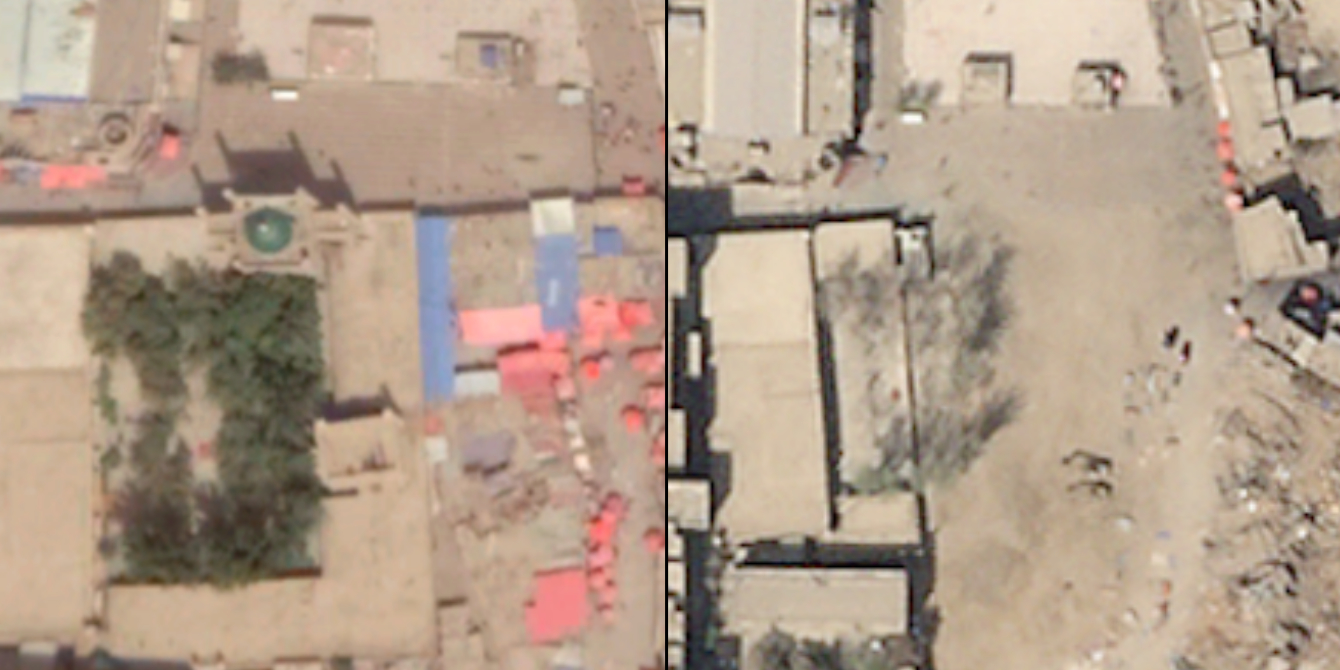- China is waging an unprecedented crackdown on a Muslim minority called the Uighurs, who live in the country’s western frontier region, Xinjiang.
- Muslims have for centuries settled in the region, sometimes referred to as East Turkestan.
- As part of its crackdown, which has seen the installation of facial-recognition cameras and seemingly arbitrary detentions, China’s government has also destroyed traditional Uighur architecture including mosques and large parts of an ancient city called Kashgar.
- Before-and-after images show the extent of some of the destruction of these historical locations.
- Visit Business Insider’s homepage for more stories.
China is installing a 21st-century police state in its western frontier of Xinjiang, which is home to the Uighurs, a majority-Muslim ethnic minority.
It involves installing hundreds of thousands of facial recognition cameras, making Uighurs download software on their phones, and holding at least 1 million Muslims in prison-like detention centers.
Beijing is waging this crackdown partly because it sees Uighurs as a national security threat, and has tried to stoke Islamophobia to justify its controversial policies in the region.

As a part of the crackdown authorities have also been razing historic architecture around the region.
Over the past two years, China has started destroying mosques - either by removing various parts, like gatehouses and domes, or by razing the entire structure - around Xinjiang as part of its campaign to marginalize Muslim culture and "sinicize" religion in the country.
Scroll down to see before-and-after images of Uighur architecture being destroyed. They are just three of many such examples.
Kargilik mosque - all gone
Satellite images taken in September 2018 and April 2019 appear to show that a mosque in Kargilik county, southwest Xinjiang, had been demolished completely. The two structures in the red box serve as location markers for the before and after images.
The photos were first analyzed by Nick Waters, an open-source analyst for Bellingcat.
This first image was taken on September 1, 2018.

This image taken on April 1, 2019, shows the mosque completely gone.

The gradual dismantling of a mosque as old as Notre-Dame
Satellite images analyzed by student activist Shawn Zhang and Waters show that parts of Keriya Aitika mosque, had been razed.
The mosque, located in the southwestern Xinjiang city of Keriya, dates back to 1237 AD - making it almost as old as the Notre-Dame Cathedral, which was completed in 1345 AD and was devastated by a massive fire earlier this month.
The photo below shows the gatehouse - which leads to the main prayer hall - of the mosque in 2012.
That gatehouse now appears to be gone.
Here's a satellite image of the gatehouse in October 2017, as Zhang and shared with Business Insider:

... and in May 2018. It appears to have completely disappeared.

According to two satellite images taken on March 19 and 20, 2018, it appears that the gatehouse and another building to its south - which leads into the main prayer hall - were destroyed some time on those two days.
This was taken on March 19, 2018 ...

... and this was taken on March 20, 2018.

Why the government chose to take down the gatehouse and the building behind it, but kept the main prayer hall, is not clear.
James Millward, a Uighur expert and professor at Georgetown University, suggested that mosque gatehouses have been targeted because they bear the domes of the places of worship.
Xinjiang authorities have passed policies forbidding prominent Muslim markers, such as headscarves, long dresses, and beards. In 2017, China also banned Uighur parents from giving their children traditional Islamic names, like "Mohammed" and "Fatima."
2/6 Need more textual confirmation, but my suspicion is that the gatehouses have been targeted, sometimes leaving prayer halls, because the gates bear the domes. Domes have been branded "Arabic" style architecture in PRC and vilified in the "sinicization of religion" campaign.
— James Millward 米華健 (@JimMillward) April 24, 2019
The razing of an ancient city to make for easier patrolling
China started its yearslong process to tear down the historic Old City of Kashgar, which is approximately 2,000-years-old and later became a tourist attraction, in 2009.
Regional authorities continue to demolish various parts of the historic city, though they have kept one or two well-known structures - like the Id Kah mosque - intact.


The government justified the destruction of the Old City and the construction of the "new Old City" - which would be complete with new apartment complexes and shopping malls - as a means to prevent the old structures from crumbling and to allow for better sanitation, The New York Times reported at the time.
The demolition has also created wider streets, which has made the area easier to patrol.

Lawrence Butler, an Islamic architecture expert and emeritus professor at George Mason University, described the Old City as a "time-capsule" of Uighur history.
"What they've done to Kashgar breaks my heart - back in the 90s it was a wonderful time-capsule of a city, with the market and crafts neighborhoods surrounding the great mosque intact, so that one could appreciate the entire living organism of a traditional Islamic market town where the sacred and the commercial are intertwined and mutually supporting," he told Business Insider.
"Razing that, preserving one or two isolated structures like the great mosque, destroys the historical context."
"A concern frequently raised by Uighur observers is that Beijing wants to neutralize the Islamic monuments by Disney-fying them - polish them up, bring in the tourist buses, banish the Muslims," he added.

Rachel Harris, an expert in Uighur culture and reader in ethnomusicology at SOAS University of London, wrote in The Guardian: "Whole cities are being redesigned to facilitate maximum security and surveillance of the local population."
Scholars and activists have also warned of Beijing's efforts to eradicate Uighur culture.

The Xinjiang government denies that its destruction of historic Uighur architecture has anything to do with its Muslim crackdown.
"This argument that 'shantytown redevelopment is intended to force some Uighur migrants to leave the city and place others in residential buildings that are easier to monitor' is a slanderous fabrication," it told The Wall Street Journal earlier this month.
- Read more about the Uighurs in Xinjiang:
- Relatives of China's oppressed Muslim minority are getting blocked online by their own family members, who are terrified to even tell them how bad their lives are
- A wave of Islamic countries started to stand up to China over its persecution of its Muslim minority. But then they all got spooked.
- This map shows a trillion-dollar reason why China is oppressing more than a million Muslims
- This man's family vanished in China's most oppressed region. The next time he saw his son was 2 years later, in a Chinese propaganda video.

